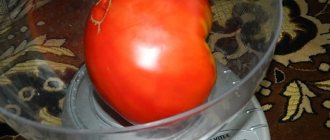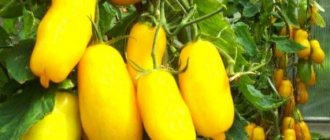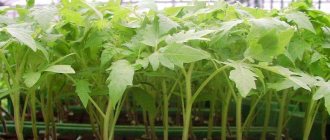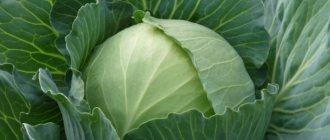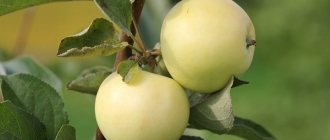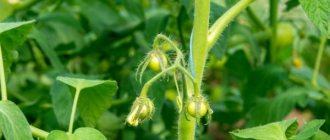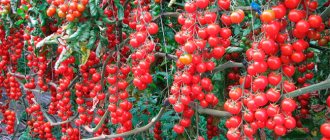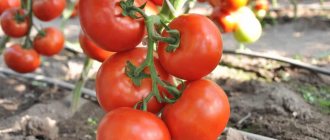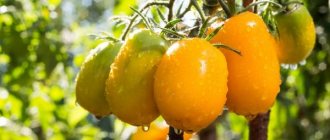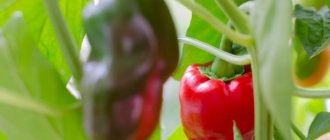Description of the variety
White filling 241 has been known to Russians for more than 50 years - the variety was registered in the Unified State Register in 1966 by Kazakh breeders. Today we sell seeds from two and the Timofeev breeding station.
Many people mistakenly believe that Belyi naliv and Belyi naliv 241 are different subspecies of the same tomato variety, but this is not the case.
In the product description, the manufacturer indicates that the variety is early ripening and productive. Susceptible to fungal diseases. Recommended for open ground.
Distinctive features
Tomatoes are heat-loving plants. Therefore, selected for regions with cold summers (North, North-West and Western Siberia, as well as Central, Central Black Earth, Volga-Vyatka and Middle Volga regions), White filling has become a real find for summer residents. It is unpretentious in care and is considered the easiest to grow.
Determinate variety. The height of the bush is from 50 cm (in open ground) to 70 cm (in a greenhouse). Persistent, strong stem. The roots of the plant grow up to 50 cm in width, but do not go deep. The leaves are medium sized, light green in color. The fruits stay on the bush well and do not fall off.
Fruit characteristics and yield
The first fruits appear on the bush after 80-100 days. In open ground in cool summers, ripening occurs later.
From one bush, 2-3 kg of tomatoes are harvested with an average weight of 100 g. As can be seen in the photo below, fully ripened fruits are red, round, smooth, with thin skin. They have a sweet-sour taste, aromatic, with juicy pulp. The fruits do not crack and withstand transportation and storage well.
Advantages and disadvantages, features, differences from other varieties
Like any other varieties, the White filling tomato has advantages and disadvantages, but the fact that it successfully competes with many new varieties and hybrids indicates that it has more advantages than disadvantages. The obvious advantages of the variety include:
- unpretentiousness to growing conditions;
- adaptability to different weather conditions;
- high, for an early variety, yield of beautiful, medium-sized fruits;
- transportability of the crop;
- versatility of use;
- good taste and strong aroma;
- the friendly ripening of one part of the crop and the expansion of the other;
- resistance to light frosts.
Disadvantages can be considered:
- average resistance to diseases;
- inconspicuous presentation of not fully ripened fruits;
- the taste is not for everybody: not everyone likes the characteristic sourness of this variety.
The transportability of fruits is associated with such a feature as a very dense skin. While being a plus from the point of view of the safety of tomatoes, this fact perhaps brings a negative connotation to the consumer (taste) characteristics of the fruit.
The name “White filling”, which is completely suitable for apples of this variety, causes confusion in the case of tomatoes. After all, fully ripe (“full”) fruits are red in color, and they pass through the white color stage during the ripening process.
The variety bears fruit well in any weather conditions, but in the case of sharp fluctuations in daily temperatures, there is still a high probability of fruit cracking. The first part of the harvest, as a rule, is excellent, but the success of the ripening of the remaining fruits is highly dependent on the weather.
Without questioning the unpretentiousness of the variety, I would like to argue with statements about the excellent taste of tomatoes. There are many varieties that are almost as unpretentious as White Pouring, but which, in the opinion of the author of these lines, produce more delicious fruits. This variety, in particular, is the Betta tomato. It ripens significantly earlier than Belyi naliv, and bears fruit with slightly smaller, but beautiful and tasty tomatoes. It is as unpretentious in care as White Pouring. Although, of course, “it depends on the taste and color...”. Probably, other gardeners will name a lot of other very worthy varieties.
Video: White tomatoes on the bushes
How to grow seedlings
Seeds are planted for seedlings in the third decade of March. After just one and a half to two months, the plants are ready to be planted in the garden. It is important to properly prepare the grains before planting.
Seed preparation
It is necessary to start preparing seeds 1-2 weeks in advance. First of all, choose good grains - they should be large, smooth to the touch, full inside. Empty, small, irregularly shaped seeds are not planted - the likelihood of obtaining viable seedlings from them is low.
One old, proven method will help you select the “right” grains: stir a tablespoon (2.5 g) of table salt in 1 glass of water (250 ml). Place the seeds in the solution for 15-20 minutes. Throw away those seeds that float to the surface, and select those that sink to the bottom for planting.
Then heat the grains. To do this, place a cotton cloth on a hard flat sheet and place the seeds on top. Place this design on a central heating radiator for 36-48 hours.
The next stage of seed preparation is disinfection. To do this, prepare a 1% solution of potassium permanganate and place the grains in it for 15-20 minutes.
Important! Potassium permanganate does not affect diseases and pathogens that live inside the grain, but copes well with pathogens on the surface of the seeds.
After the procedure, rinse the grains with lukewarm running water.
Some summer residents insist that dressing is not necessary for purchased seeds - this has already been done at the manufacturer.
Next, the seeds are saturated with oxygen. This procedure is called “bubbling”. It is performed both manually and by machine. Hardware processing is suitable for large-scale production; people can do it themselves at home. To do this, heat the water to a temperature of +26 – +30 degrees and place 20-30 grains in it. Stir the water with the seeds once an hour. The duration of the procedure is 15-18 hours, but when embryos appear on the grains, bubbling is stopped immediately.
Then soak the ungerminated seeds. Place the grains in water at room temperature for 12 hours. Sometimes, instead of water, a solution with biological stimulating drugs is used.
Experienced gardeners use such tools as:
- "Zircon".
- "Epin."
- "Immunocytophyte".
When soaking grains in biostimulants, remember that the latter only work at an air and liquid temperature of +20 degrees.
The next stage is hardening. Summer residents often skip this stage of preparation due to its complexity - an incorrect procedure kills the seeds. However, if hardening was successful, this will greatly increase the viability of seedlings during spring frosts.
Wrap the grains in cotton cloth and polyethylene and place them in a cool place with an air temperature of +2 -3 degrees (a refrigerator or balcony is suitable for this). After 8 hours, return the seeds to a warm room for 8 hours. Repeat the procedure 5-6 times.
Before planting in the ground, germinate the tomato seeds. To do this you will need cotton cloth or gauze. Moisten the fabric with warm water and place it on a flat dish. Place the seeds on a cloth and cover with another layer of damp cloth. To germinate grain, place in a warm (+25 - +30 degrees) place and make sure that the fabric always remains damp. As soon as a sprout appears from the grain, equal in size to the grain itself, it can be planted in the ground.
Container and soil
Any container will do - special containers sold in stores, plastic cups, used yogurt, cottage cheese or sour cream containers, lids from cake packages, cut-off plastic bottles. Regardless of the choice, the container is disinfected in a 5% solution of potassium permanganate.
A universal soil for tomatoes is suitable. You can buy it in the store. Soil mixture composition:
- humus;
- peat;
- river sand.
To prepare soil for tomato seedlings yourself, combine:
- 1 part of garden land where cucumbers, zucchini, carrots, dill grew;
- 2 parts non-acidic peat (pH 6.5);
- 0.5 parts sand (river or washed);
- 1 part humus or sifted mature compost.
You can add sifted wood ash (or dolomite flour), sphagnum moss, fallen pine needles.
Attention! A day before planting seeds, disinfect the soil: treat with boiling water or potassium permanganate.
Sowing
Place the seeds at a distance of 2-4 cm. Sprinkle with a layer of soil no more than 2 cm and spray with water from a spray bottle. Cover the containers with film or glass (you can use a regular plastic bag). In the room where the containers will be placed, the temperature should be above +20 degrees.
Growing and care
As soon as the first shoots appear, remove the film and place the container on a bright windowsill. Water small seedlings as the soil dries using a syringe or a teaspoon under the root, avoiding moisture getting on the cotyledon leaves.
Important! Tomato seedlings do not like direct sunlight.
In the phase of two true leaves, the seedlings are picked. To do this, plant each plant in a separate container, digging almost to the cotyledon leaves. Add mineral fertilizers to the soil for replanting at the rate of 1 tbsp. spoon for 5 liters of soil mixture.
Be sure to make holes in the container to allow excess liquid to escape. 10 days after picking, feed the tomatoes with complex fertilizer. Repeat feeding every 14 days. Water as the soil dries out and always at the roots.
Immediately after transplanting, start hardening the tomatoes. To do this, in the evening, take the pallets with cups out onto the balcony or outside, first for one hour, then for two, gradually increasing the time spent in the air to 12 hours. Similarly, plants are accustomed to sunlight.
Boarding order
Tomatoes are grown using the seedling method. First, the seeds are planted, while the grown tomatoes are transferred to a greenhouse or an open-air garden bed. The soil for planting in the fall is fertilized with humus.
Obtaining seedlings
Tomato seeds are planted in small boxes filled with garden soil, humus and peat. It is recommended to first place the soil in a hot oven or microwave. The treated soil is left for two weeks.
Work begins in the second half of February. The seeds are soaked for a day in water, to which you can add a little salt.
Important! Seeds are planted every 2 cm in furrows to a depth of 1 cm.
The containers are covered with film or glass, then moved to a dark place. To germinate, seeds require a constant temperature of 25 to 30 degrees.
After sprouting, the tomatoes are moved to a windowsill or other place where there is access to light. Plants are provided with access to sunlight for 12 hours. As the soil dries, White Naliv tomatoes are sprayed with warm water from a spray bottle.
Two weeks before planting the plants in the garden, they are transferred to the balcony, where the temperature is maintained at 14-16 degrees. The first few days, seedlings are hardened off within 2 hours. Gradually, the time she spends in the fresh air increases.
Growing in a greenhouse
Soil preparation in the greenhouse for White filling tomatoes is carried out in the autumn. It is recommended to completely replace the top layer of soil 10 cm thick, since insects and fungal spores overwinter in it.
The soil for the tomatoes is dug up and humus is added. Tomatoes are not grown in the same greenhouse for two years in a row. Tomatoes are not planted after eggplants and peppers due to the presence of similar diseases. For this crop, soil is suitable where onions, garlic, beans, cabbage, and cucumbers previously grew.
Important! Tomatoes develop best in loose loamy soil.
The seedlings are transferred to a heifer at the age of one and a half to two months. Holes 20 cm deep are prepared for the tomatoes. They are placed in a checkerboard pattern in 30 cm increments.
The tomatoes are carefully transferred into the holes along with a lump of earth and covered with soil. The soil should be compacted, after which the plants should be watered abundantly.
Planting in open ground
Tomato White filling is transferred to open ground when constant warm weather sets in, when spring frosts have passed. At this point, the seedlings have a large root system, a height of up to 25 cm and 7-8 leaves.
The planting area must be protected from the wind and constantly illuminated by the sun. It is necessary to prepare the beds in the fall: dig them up, add compost (5 kg per square meter), substances with phosphorus and potassium (20 g each), nitrogen-containing substances (10 g).
Advice! White filling tomatoes are planted in holes 20 cm deep.
Plants are placed at a distance of 30 cm. 50 cm is left between rows. After transferring the seedlings, the soil is compacted and watered. A wooden or metal peg is installed as a support.
How to grow tomatoes
When the seedlings become stronger and reach a height of 20 cm, they can be transplanted into the beds.
Landing
It is better to plant tomatoes on the south or southeast side of the garden. A good harvest is obtained on loamy or sandy soils, where cucumbers, onions, and zucchini used to grow. Tomatoes, sweet peppers, eggplants and potatoes are considered bad predecessors - the plants only suffer from infections.
Tomatoes do not like crowding, so the optimal distance between bushes is 50 cm. A good planting method is square-cluster: plant the bushes in the corners of an imaginary square, each side of which is 50-60 cm. In the center, make a watering hole with a diameter of 40 cm, at the bottom of which lay out 1 liter of ash or a handful of superphosphate and potassium sulfate, and on top - cut grass without seeds and rhizomes.
Tomato care White filling
The variety is not picky in care. Abundant root watering is necessary 2 times a week, before sunrise. Avoid watering in the evening if the air temperature drops below +20 degrees at night, otherwise the tomato will become infected with fungus.
The roots of the plant need oxygen, so weed and loosen the soil often. Hill up when lateral roots form.
Two weeks after planting in the beds, the plants can be fed with both organic and inorganic fertilizers. Fertilizing is carried out twice more during the formation of the ovary.
Important! Through moistened soil, nutrients will reach their intended destination faster, so tomatoes need to be watered before applying fertilizer.
White filling tomatoes do not require pinching or bush shaping. But to increase productivity, leave 2-3 stems on the plant. Cut off the stepsons carefully - it is better when they reach a length of 4-5 cm, when it is easier to assess their viability. It is allowed to remove unnecessary ones after the start of flowering. In this case, it is better to tie up the bushes - the fruits will be larger and the plant may fall to the ground.
Important to remember! It is advisable to remove stepchildren by hand. When using a knife, there is a high probability of transferring diseases on the blade from bush to bush. If you use a knife, the blade should be disinfected when switching to a new plant.
Features of cultivation and possible difficulties
One of the significant difficulties in cultivation is the susceptibility of the variety to late blight. Therefore, it is not advisable to plant White filling 241 next to potatoes or in an area where potatoes grew previously - fungal spores may remain in the soil or be transferred from diseased neighbors. In addition, water the tomatoes only at the root and remove the lower leaves.
Diseases and pests
White filling 241 is an ultra-early tomato variety. Fruit ripening begins in late July - early August, and fungal diseases actively spread in late summer - early autumn. Therefore, when planting tomatoes early, phytosporosis does not have time to infect the bushes. However, if you planted tomatoes later than the time recommended by the manufacturers or in case of prolonged cool and wet weather, carry out preventive treatment of the bushes with a Fitosporin solution.
Nasturtium or marigolds planted near tomatoes save from pests - their smell repels many harmful insects.
Planting seedlings in a permanent place
Tomatoes are planted in late spring early summer, depending on the weather and climate of your region. There is no need to rush with planting to avoid frost, but there is no need to delay too much - the plant will grow in size, not in strength.
If you are not a beginner in gardening, you can choose suitable soil for White filling from the following crops:
- White cabbage;
- all types of legumes;
- cucumbers
With such predecessors, nutritious soil awaits the tomato bushes, and a rich harvest awaits you. The place should be sunny so that all the juices go into the fruits and not into the growth of bushes. Unsuitable beds are those in which eggplants and potatoes grew.
Before planting, it is best to apply a scheme at the rate of 40 cm by 50 cm - one seat. The soil is prepared in parallel with the hardening of the seedlings: sprinkle the soil evenly with humus, compost or wood ash. The volume of fertilizers per 1 square meter. equal to the volume of a standard bucket.
In each hole you can additionally place a handful of humus from one tbsp. spoon of ash. If you don’t have such a fertilizer at hand, then use a store-bought mixture.
Did you know? The tomato is a member of the nightshade family, just like tobacco and potatoes.
Fertilizers are mixed with the soil, the hole is filled with settled water without sediment, then wait for the water to be absorbed. Now the place is ready to receive seedlings.
Harvesting and application
The fruits are harvested at about 100 days. Used in preparing fresh salads, hot dishes and frozen dishes. Tomatoes of this variety are excellent for canning because they do not crack. They are used to prepare sauces, ketchups, and tomato paste. But “White Naliv” tomatoes are not suitable for making juice - the juice is too thick.
Fresh fruits are stored for a week. If you pick them from the bush while still unripe, the period will increase to 2-3 weeks.
For reference! During the ripening process, the fruits are white - hence the name of the variety.
Pros and cons: White filling tomatoes
So today many new and improved varieties are being developed; the shortcomings of the old ones immediately become obvious. White filling has a relatively low yield, and not the highest resistance to diseases. But for many summer residents, these disadvantages are not a reason to stop growing tomatoes of this particular variety.
After all, there are undeniable advantages:
- Very friendly precocity;
- Excellent taste;
- Unpretentiousness regarding weather conditions;
- Unpretentiousness regarding regular care.
Among the advantages of White filling tomatoes, it is worth noting their juiciness and rich aroma.
Even in the cold summer, you can safely count on a harvest. This variety will also tolerate heat well. But temperature changes at night and during the day can, unfortunately, lead to cracking of the fruit.
Variety Apple-tomato: 6 indicators Yulia Minyaeva: feeding tomatoes in “diapers” Growing green tomatoes in a barrel: 3 soil compositions Delicious yellow-red tomatoes: description of varieties
Farmer reviews
People who plant White filling note that, despite its susceptibility to fungal diseases, the variety is easy to grow, and thanks to its early ripening, it easily avoids infection and death of fruits before late blight outbreaks begin.
Margarita Torshina, Chelyabinsk: “Seed germination is good. The bushes of Belyi naliv are low, there are a lot of fruits on the bushes. The white filling does not crack. The taste and smell are tomato, pleasant. The taste is slightly sour. Despite the slight sourness in taste, the child ate the White filling tomato with pleasure. I think that next year I will plant these tomatoes, I really liked them.”
Svetlana, Orel: “These plants tolerate both low and very high temperatures. When caring, feeding is required every 10 days and watering is abundant, but not frequent. The fruits of this variety also do not crack, which is also good, especially in rainy and cold summers. The variety is early ripening - tomatoes can be harvested within 100 days after planting. For me, this variety will not come out of personal preference, although now there are new varieties that are more productive and more resistant to diseases. But this variety, due to its precocity, manages to ripen and bear fruit before outbreaks of late blight and other diseases.”
Features of growing in open ground
Open ground is dangerous for tomatoes due to unpredictability, weather influences and temperature changes. Don’t worry and put off planting; with proper care, you will be pleased with the harvest.
Watering
Watering is done every three days, irrigating not so much the leaves as the root zone. The watering volume is 2-3 liters per bush. If the weather is rainy, the watering schedule is adjusted.
In greenhouses, watering can be drip. You can build such a system yourself using plastic bottles. In open ground, they often water along the furrows, especially if the bushes are hilled. This method allows you not to pour water on the leaves, but only feed the roots.
Feeding
Fertilizer for tomatoes is a must, and tomatoes benefit not only from root fertilizers, but also from those that are sprayed on the leaves. If the bushes develop well, then fertilize the soil for the first time three weeks after planting in the ground. If you notice that the bushes are weak, you can fertilize earlier.
Useful fertilizers:
- Mullein infusion, which is added to the roots. Method of preparation: dilute 1 part of cow manure in 5 parts of water, close the container tightly and infuse the mixture for two weeks, stirring daily. Then dilute in water in a ratio of 1:10, add superphosphate (100 g per 10 liters of water), let it brew for 1 hour. Each bush requires approximately 1 liter of fertilizer.
- Nettle tincture. Fresh grass is poured with water at a ratio of 1:2 and infused in a barrel for 7 days.
- Infused wood ash. Add 500 ml of sifted ash into a bucket of water, add two teaspoons of boric acid and mix. After the composition has infused, it is diluted with water another 10 times. Approximately 1000 ml of infusion is poured under each bush.
- Bordeaux liquid. Leaves are sprayed with it to combat diseases: late blight, cladosporiosis.
You should not often feed White filling with organic fertilizers rich in nitrogen (bird droppings, cow and horse manure). They should be alternated with other options listed. Otherwise, you risk creating a gorgeous spreading bush, but without tomatoes.
Stepsoning
Many novice gardeners are wondering: should they plant White filling tomatoes or not? So, experienced agricultural technicians claim that it is enough to just remove the damaged lower leaves: yellowed, dry, and stained.
Important! If your region has a short summer period, then the stepsons are still harvested, forming a bush with several stems.
Soil care
Tomatoes need weeding to remove weeds and loosening of the root zone, which will enrich the soil with oxygen. After each watering, it is advisable to loosen the soil. But it would be even better to keep the soil under a layer of mulch. In greenhouses, mulching is carried out in order to accelerate the ripening of the crop and its volume.
In open ground, this procedure also ensures productivity and also saves your effort in caring for the beds. The soil under a layer of peat, straw or humus will be protected from drying out and from the constant growth of weeds.
Inside the covering surface there will be a microclimate suitable for humidity and temperature, favorable for the root system.
Thus, mulched beds do not require weeding or loosening. Before the fruits ripen, it is advisable to cover the bushes with damp soil so that lateral roots develop. This will increase the flow of microelements and provide the tomato with additional nutrition.
But not all gardeners do this procedure, since there is a risk of exposing the main root. In addition, you will have to water the hilled plants using an irrigation furrow, which is not suitable for everyone.
Find out why the leaves on tomatoes turn yellow and what preventive measures can be taken.
Tying up a bush
A garter to the stakes is not a prerequisite, but is needed to prevent strong winds or heavy rain from knocking down the bush. The tomatoes will be covered in dirt, and the bush itself may be damaged. As for greenhouses, there are nuances - the bush grows higher than in open ground, and can tilt under the weight of the fruit.
The garter is done when the bush has reached 30 cm. The stem is tied with twine to the pegs dug next to the bushes in several places, but not tightly, but only to hold it in an upright position.
Preventive measures against pests and diseases
- Start preventing tomato diseases in the fall. To do this, remove all weeds from the area for future planting of tomatoes. Then dig up the entire area for the winter, add wood ash, which is not only a fertilizer, but also a good disinfectant. It is also advisable to spray the area with a pest control agent. This way you will be able to destroy, if not all, then most of the larvae of harmful insects.
- Twenty days before planting, treat the seedlings with a half percent solution of Bordeaux mixture or copper sulfate.
- Before planting seedlings in the ground, sprinkle a little ash or onion peel into each hole.
- Do not plant White Fill next to a potato plot, where Colorado potato beetles are sure to appear.
- Plant nasturtiums or marigolds nearby. The smell of these plants repels insects.
Many gardeners who have planted such tomatoes more than once assure that in order to increase productivity, it is worth leaving only 2-3 stems on each White Filling bush and cutting off the rest. True, then the tomatoes will be noticeably larger, and the branches will have to be tied up. At the same time, gardeners advise regularly weeding the beds and hilling the bushes to allow lateral roots to appear.
Olga Danilina
Subspecies and options
The apple variety “Daughter of Papirovka” is a summer apple variety and was developed as a result of hybridization of Papirovka varieties.
In circles of specialists and gardeners with experience, the Baltic variety Papirovka is considered to be bred from the Russian White filling. In the Baltics, America, Rus', Ukraine.
Specialists at the breeding station in Sverdlovsk created the Naliv Isetsky variety.
Lifespan on different rootstocks:
- There is an interesting story about a gardener. Talking to his grandmother under the old White Fill tree, he wanted to clarify the age of the apple tree. I like my grandmother’s answer: “When I got married, she was already growing up.”
- 20-25 years – common. But not on a dwarf rootstock.
Dwarf
- Their productivity is higher.
- You can plant where you can’t grow vigorous ones due to high groundwater.
- Plant it. If there is not enough space in the garden.
- Very easy to care for. After all, the height is up to 3 meters.
- They begin to bear fruit after 2-3 years.
- Pay more attention to watering, fertilizing, and agricultural technology.
Semi-dwarf
- The white filling on a semi-dwarf rootstock is almost indistinguishable from a dwarf one.
- Now it grows - and determine where it is: The difference in size is about 25%.
- Height – up to 4 meters.
creeping
It was I.V. Michurin who recommended growing low-growing forms and horizontal cordons. As one of the most frost-resistant in Siberia.
But these are not varieties, but forms.
Once again!
White filling is an early summer variety with large (up to 200 g) and more medium (80-120 g) apples. But in winter it’s problematic to eat it!
Caring for tomato seedlings
Caring for seedlings of this variety does not cause much trouble, and growing them yourself guarantees that you will obtain this particular variety.
Lighting
Young plants need enough light, but they must be protected from direct sunlight.
You can place the containers on the windowsill in a room where the sun shines early in the morning or only in the evening. Or you can create partial shade by closing the blinds, as well as using newspapers and pieces of wallpaper. In the evening, a table lamp or fluorescent lamp is suitable for additional lighting.
Watering
Plants that have already been planted should be watered as the soil dries out. Usually this is three times a week and always at the root. The cups must have holes so that the water does not stagnate, as excess moisture causes blackleg disease.
Top dressing
The first fertilizing with a special complex fertilizer is carried out no earlier than ten days after the dive. The fertilizer should be specifically for seedlings, since babies may not be able to “digest” the adult food. Next - another feeding two weeks later, and the last one - two weeks before the expected planting.
Hardening
You can start hardening the seedlings immediately after germination - take them out to the balcony for three days in a row at +15 °C and leave for 30 minutes, then at +10 °C. Although most gardeners do this 14 days before planting in open ground. In the evening, pallets with cups are taken out onto the balcony or outside, first for one hour, then for two, etc.
After a week, you can take it out in the morning and leave it for the whole day, just not in the sun. They are also accustomed to direct sunlight gradually - they start with 30 minutes in partial shade, and every day the duration of sunbathing is increased.
Growing rules
Even before planting seeds for seedlings, they need to be properly prepared by following these steps:
- Place the planting material in a solution of potassium permanganate. After a quarter of an hour, wash it under cool water. This stage is necessary in order to disinfect the seeds.
- Prepare a solution by diluting 10 g of nitrophoska in 1 liter of water. Immerse the planting material in the liquid. This step is necessary for the successful growth and development of the plant.
- Place the seeds in moisture. The temperature should be approximately 25-30°C. The procedure should last 1-2 days, it will help the material to germinate.
Planting seedlings
The soil for planting seeds for seedlings must contain nutrients. In addition, you must make sure that the soil has a neutral acidity level. Before planting the material, the ground should be dug up using peat or humus. It can also be fertilized with potash or superphosphate.
Stages of planting seeds for seedlings:
- Buy a container for seedlings made of plastic or wood.
- Pour into it a soil mixture containing useful substances.
- Make small depressions 1 cm in size in the soil. The holes should not be closer to each other than 1 cm.
- Place planting material in the holes, sprinkle it with soil and water it.
- Cover the container with glass or plastic wrap.
- Place the future seedlings in a warm and well-lit room.
After 10-14 days, the first shoots will appear. Then the container will need to be moved to a place with a lower temperature. It should also be light. The material with which the container was covered must be removed for 2 hours. After this, the film or glass should be returned.
When the sprouts have several developed leaves, they will be ready to be planted in a permanent place.
Tomato transplant
Soil for cultivating White filling tomatoes needs to be prepared in the autumn. To do this, it is fertilized with substances such as compost, ash and egg shells.
If you plant tomatoes in a greenhouse, you should do this in May, in open soil - in May or June (depending on climatic conditions). 1 m2 should accommodate approximately 3 bushes. If you place the plants even more densely, their yield will decrease significantly.
Before moving the seedlings to a permanent location, the soil must be loosened. Fertilizers containing calcium sulfate and superphosphate must be placed in the recesses dug for the sprouts. A maximum of 1 tsp can be used for each hole. substances.
After planting young plants, they need to be watered abundantly.
